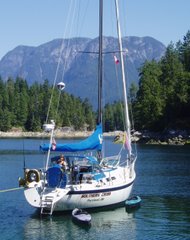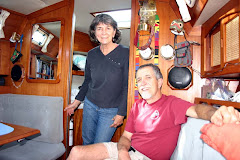
The desert vegetation here is really something. Some of the cardon cactuses must have been 60 feet high and 3 feet in diameter. Eventually we came to the edge of the plain and started winding up into the hills, until we came upon this vista.

At this point we were already on the ranch, which is 1000 acres in size. But we had to cross this canyon to reach the ranch headquarters, up high on the opposite ridge. You might be able to see a splash of green from the trees planted around the ranch house.

Finally we arrived, and Doctor Ruiz, Memo's father, proudly showed us around. He has been planting trees here for the past 18 years that he has owned this ranch.

There were date palms, papayas, mangos, guavas, avocados, zapotes, peaches, a variety of citrus trees, and a few trees I had never seen before. Here is Vicki, breathing in the fragrance from the orange tree blossoms.

Water arrives here through a black plastic hose, 2.5 kilometers long, from a spring high on the nearby mountain. Memito, between his two grandfathers, enjoyed tossing lemons into the cistern.

After squaring away some business with the ranch hand, Memo set to work preparing lunch for all of us.

He is an excellent cook, and the marinated asada tacos were some of the best we have ever tasted. Here we are feeling sleepy after tacos and beer.

There are only about 100 head of cattle here. I asked Doctor Ruiz how many hectares it takes to support one cow. The answer: 35 (over 80 acres). These cows are happily chowing on sorghum hay that was brought up from the irrigated farms back at San Juan de los Planes.

This was another great side trip, and we are grateful to our Paceño friends for showing us their beautiful ranch!




